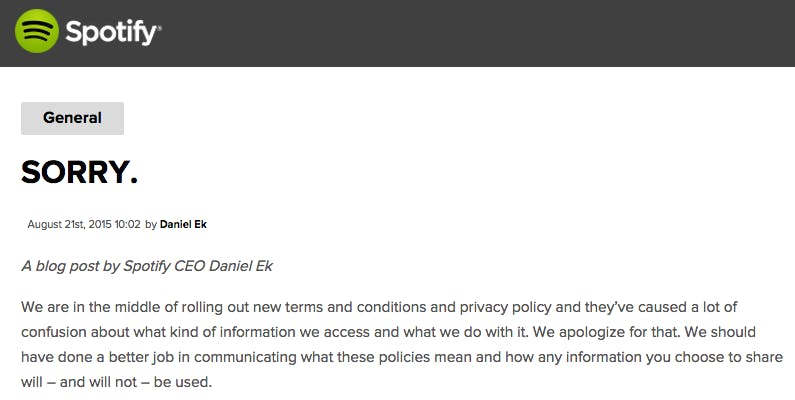Spotify can’t afford any mistakes.
With Apple Music breathing down its neck, the popular on-demand streaming service needs to keep its users happy—and paying. Spotify’s new terms of service (ToS) just raised eyebrows when the new documentation requested permission for Spotify to access to a mobile device’s photos, location data, voice, and contacts.
On Friday, Spotify issued a clarification for the updated ToS along with something rare indeed: an apology. In a blog post simply titled “Sorry,” Spotify CEO Daniel Ek apologizes for the confusion. “We will ask for your express permission before accessing any of this data—and we will only use it for specific purposes that will allow you to customize your Spotify experience,” Ek explained.
Ek went on to clarify why Spotify requested these controversial forms of data at all, noting that future versions of Spotify might further personalize the user experience with these other kinds of data, generating cover art from a user’s photo roll, implementing voice controls, and customizing trending music suggestions based on location.
Unfortunately, the controversy around Spotify’s aggressive ToS demands is far from unique. Software companies are rarely forthcoming about the sort of data they collect and monetize behind the scenes. Even Spotify admits that it “share[s] some data with our partners who help us with marketing and advertising efforts” without further clarifying what that means exactly.
The confusion is only compounded by the oversimplified nature of location data permissions in mobile operating systems like Apple’s iOS, which generally offer and all-or-none opt in rather than granular privacy settings. Pestered with endless pop-up prompts for location settings, most users just give up and opt in. Spotify can promise that it “will ask for your express permission before accessing any of this data” but just how empowered that leaves your average subscriber remains to be seen.
Spotify certainly jumped the gun by requesting invasive permissions for a bunch of stuff it hasn’t even built yet, but hey, at least someone read the fine print.
Illustration by Max Fleishman



